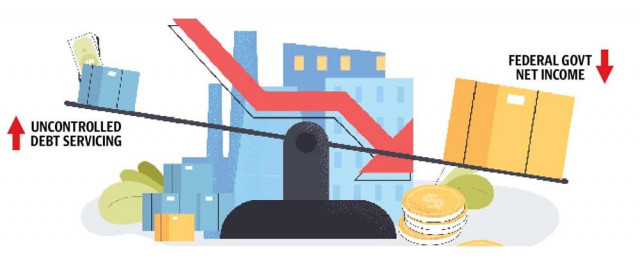Cost of debt servicing up to Rs3.18tr
Spending exceeds government’s net income, highlights need for debt restructuring

Debt servicing expenses peaked to Rs3.18 trillion during the first eight months of the current fiscal year – exceeding the federal government’s net income – underpinning the urgent need for debt restructuring to create the fiscal space required for other expenditures and to avoid default.
The federal fiscal operations details also revealed a Rs20 billion discrepancy in the tax collection claimed by the Federal Board of Revenue (FBR) for the July-February 2022-23 period, according to finance ministry sources.
According to the sources, the FBR reported Rs4.493 trillion tax collection till February – a figure that is Rs20 billion higher than provisionally reconciled by the Accountant General of Pakistan Revenue (AGPR).
After adjusting for the discrepancy, the tax shortfall during the first eight months of the current fiscal year stands at Rs232 billion.
The fiscal operations details for the July-February period showed that interest expenses have shot-up significantly to Rs3.18 trillion during the first eight months of this fiscal year. This equals 81% of the original annual debt servicing budget. There was also an increase of 70% in the cost of interest payments on the federal government’s debt stock in just eight months.
The more alarming fact, however, was that debt servicing was Rs9 billion more than the federal government’s net income during the same period. Earlier, the country’s net income was fully meeting its interest expenses while partly covering the cost of the defence budget.
Now though, the income does not to be sufficient even to meet debt servicing costs – a fact that exhibits how the country is stuck in a trap and cannot make an exit without restructuring, both its domestic and external, debt.
In the span of nearly four years, the key interest rate set by the central bank has almost doubled to 20% – significantly increasing the government’s debt related expenses. Furthermore, the interest rate is expected to increase even more as the International Monetary Fund (IMF) is not completely satisfied with the recent hike.
Pakistan has informed the IMF that the cost of debt servicing may rise to nearly Rs5.2 trillion in this fiscal year, equalling more than half of this year’s total budget of Rs9.6 trillion.
All other major current expenses, excluding defence, have shown negative growth in the first eight months. The other expenses amounted to Rs1.44 trillion, down by Rs731 billion or 34% compared to the last year.
Excluding military pensions and expenses on the armed forces development programme, Rs871 billion was spent on defence in eight months, standing at Rs117 billion or nearly 16% more than last year.
Gross revenues swelled to Rs5.6 trillion and Rs2.48 trillion of the federal tax share was transferred to the provinces. With a net income of Rs3.16 trillion, accumulative spending on debt servicing and defence jumped to over Rs4.05 trillion – 128% or Rs888 billion more than the government’s net income – suggesting that Pakistan will continue to remain debt trapped.
Furthermore, development expenses amounted to only Rs229 billion in six months, as compared to Rs420 billion in the same period of the last fiscal year. IMF Mission Chief Nathan Porter has clarified that the fund has not asked Pakistan to curtail the development budget.
Under the IMF programme, Pakistan had committed to converting its primary deficit, calculated after excluding interest payments, into a surplus of 0.2% of GDP, down from last fiscal year’s 3.6%. As a result of uncontrolled spending, however, the government will miss this target.
During the recent review talks, the IMF had agreed to relax the primary budget deficit ceiling to 0.5% of the GDP. The details, however, have not yet been made public due to a delay in reaching staff level agreement.
Moreover, the federal budget deficit widened to nearly Rs2.55 trillion in the first eight months of the current fiscal year, as the gap between expenses and revenues was equal to 3% of the GDP.
During the current fiscal year, the government’s total expenditure shot up to over Rs5.7 trillion, an increase of nearly 10%. Current expenditure rose to Rs5.5 trillion, up by 15%.
Non-tax collection also increased to Rs1.17 trillion in eight months – higher by Rs330 billion or 39%.
FBR tax discrepancy
The sources said that the AGPR has confirmed tax receipts for Rs4.473 trillion compared to Rs4.493 trillion claimed by the FBR. The Rs4.473 trillion tax collection was 15% higher than the previous fiscal year, a ratio that is less than half of the prevailing inflation rate and shows the inefficiency of the bureau.
The FBR spokesman’s reply was awaited until the filing of this story. The Ministry of Finance also did not officially respond to the question over the reporting figures by the FBR.
An official of the FBR said that the reconciliation exercise for February 2023 was still in progress as per the normal routine and such exercise is completed towards the end of the following month. Any discrepancies found, are cleared out during the process of reconciliation – this is a routine procedure, he added.
The World Bank’s recent implementation status and results report of the $400 million loan – Pakistan Raises Revenue – states that “revenue accounts reconciliation between the FBR and the treasury is done on monthly basis, although some variations are reported due to impending refunds and delayed transfer from the National Bank of Pakistan.” It added that there was no evidence of reconciliation of the assessments and arrears.
The discrepancy often occurs when the FBR resorts to taking advances on the last day and that too, after banking hours, to try to minimise the revenue shortfall, said the sources.
Published in The Express Tribune, March 19th, 2023.
Like Business on Facebook, follow @TribuneBiz on Twitter to stay informed and join in the conversation.



















COMMENTS
Comments are moderated and generally will be posted if they are on-topic and not abusive.
For more information, please see our Comments FAQ